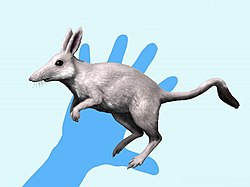| Mayulestes Temporal range: Early Paleocene (Tiupampan), | |
|---|---|
| Scientific classification | |
| Kingdom: | Animalia |
| Phylum: | Chordata |
| Class: | Mammalia |
| Order: | † Sparassodonta |
| Family: | † Mayulestidae |
| Genus: | † Mayulestes de Muizon 1994 |
| Species: | †M. ferox |
| Binomial name | |
| †Mayulestes ferox de Muizon 1994 [1] | |
Mayulestes (Quechua: mayu river, + Greek: lestes, thief) is a genus of carnivorous metatherian that lived in what is now Tiupampa, Bolivia in the early Paleocene. It shared its habitat with fellow sparassodont Pucadelphys , and a microbiotherid marsupial, Khasia . [2]




